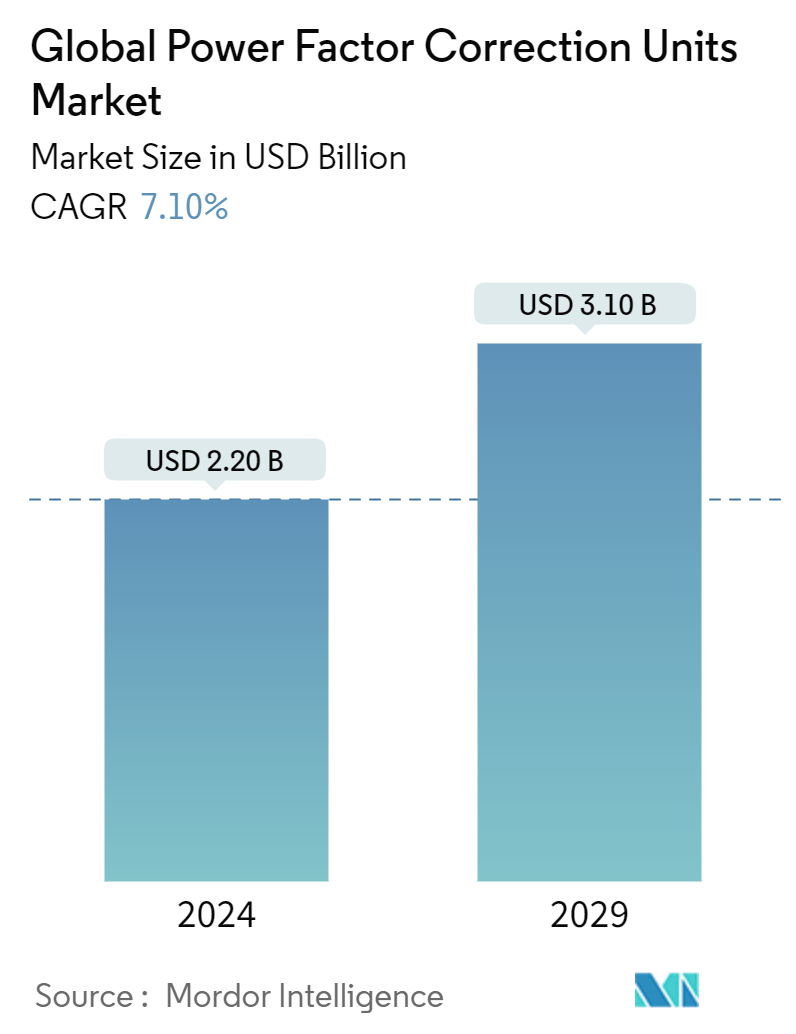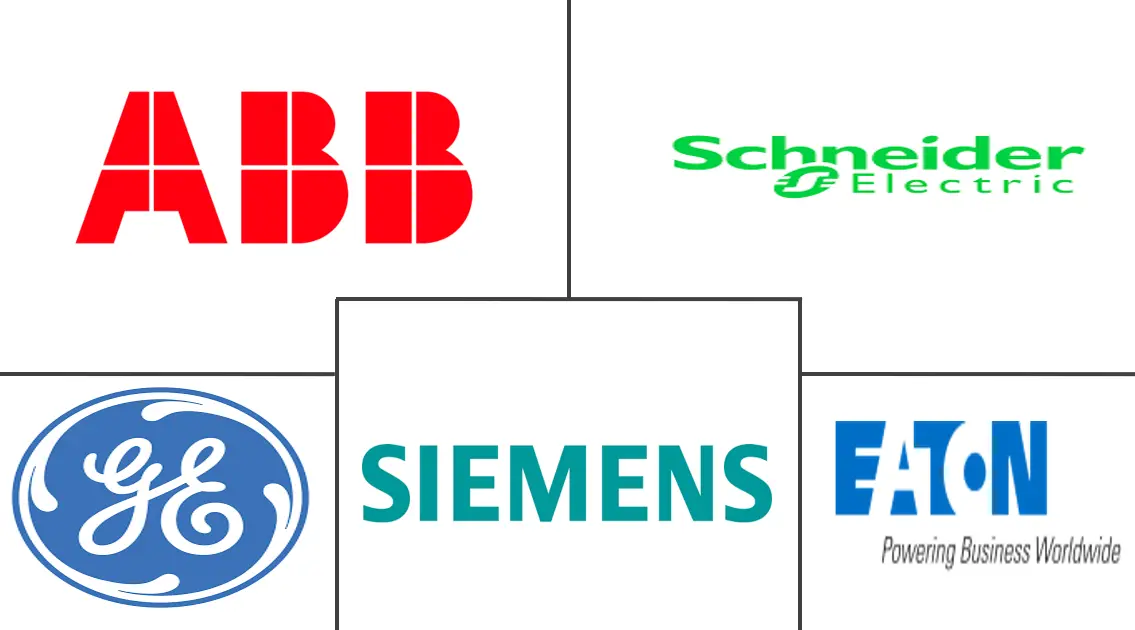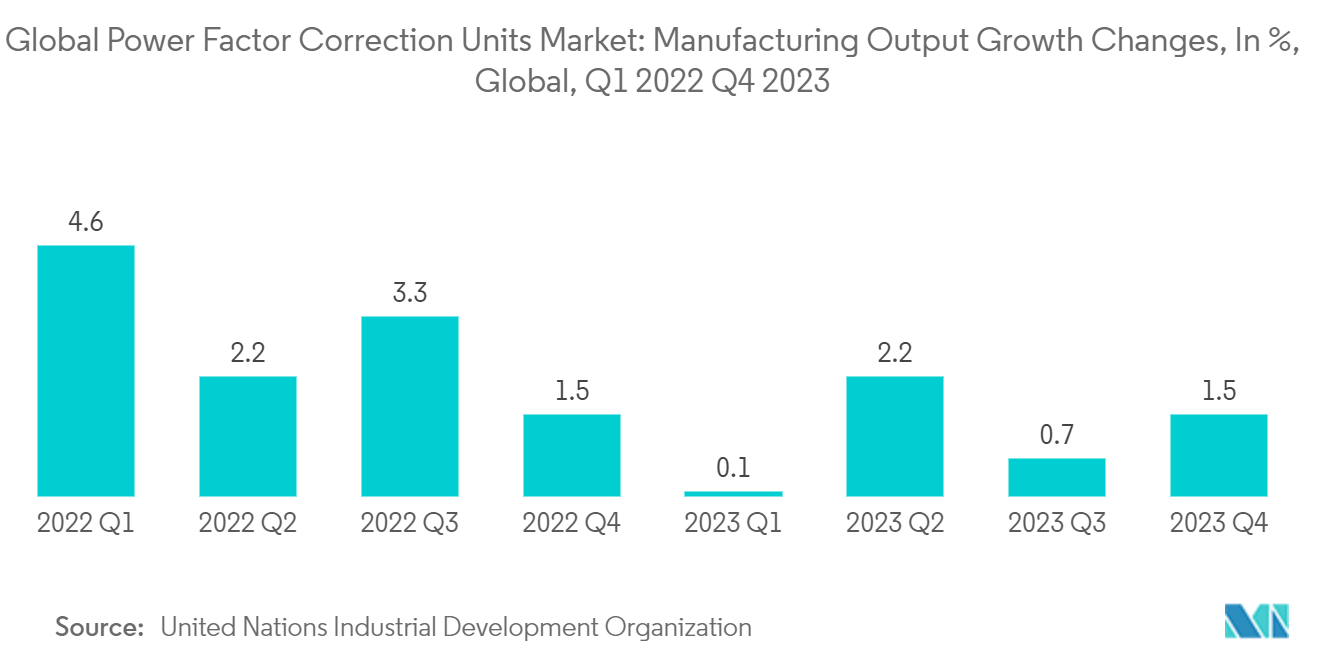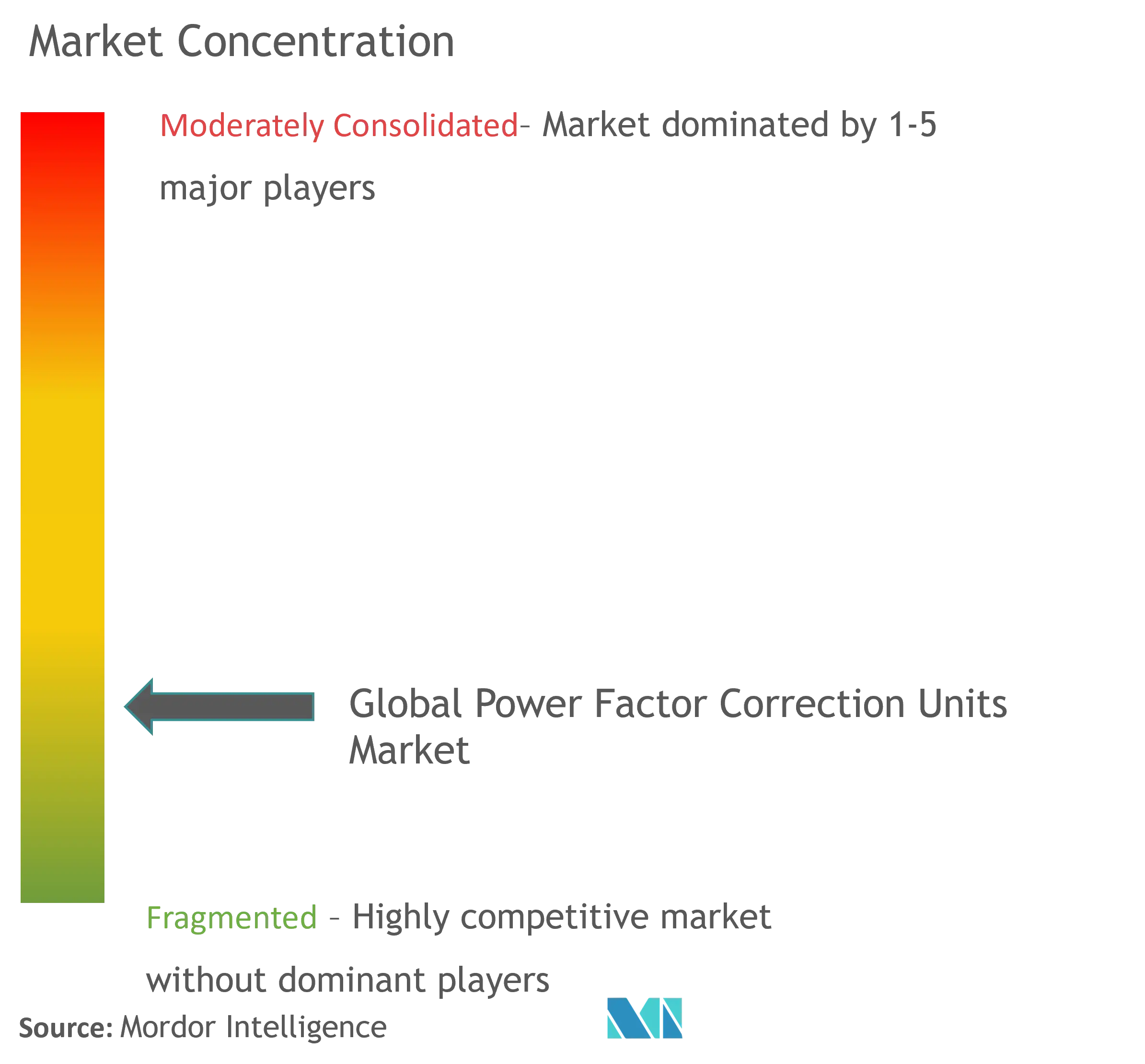Global Power Factor Correction Units Market Size

| Study Period | 2019 - 2029 |
| Market Size (2024) | USD 2.20 Billion |
| Market Size (2029) | USD 3.10 Billion |
| CAGR (2024 - 2029) | 7.10 % |
| Fastest Growing Market | Asia Pacific |
| Largest Market | North America |
| Market Concentration | Medium |
Major Players
*Disclaimer: Major Players sorted in no particular order |
Global Power Factor Correction Units Market Analysis
The Global Power Factor Correction Units Market size is estimated at USD 2.20 billion in 2024, and is expected to reach USD 3.10 billion by 2029, growing at a CAGR of 7.10% during the forecast period (2024-2029).
- Over the medium term, factors such as rapid industrialization, growing stringent regulations, and standards over energy efficiency are expected to be among the most significant drivers for the global power factor correction units market during the forecast period.
- Complicated maintenance and technical challenges are associated with these units, posing a threat to the global power factor correction units market during the forecast period.
- However, continued efforts are being made toward smart grid deployments, which require efficient power management. This factor is expected to create several opportunities for the market in the future.
- Asia-Pacific is expected to witness significant growth and register the highest annual growth rate during the forecast period. This is due to the region's growing manufacturing industry and focus on wind energy installations.
Global Power Factor Correction Units Market Trends
The Industrial Segment to Witness Growth
- The global industrial landscape has experienced massive growth and expansion in recent years due to the confluence of factors such as technological advancements, increasing automation, and a growing emphasis on efficiency and productivity. This industrial growth has a positive impact on the compressed air pipe market, strengthening its demand and driving its growth trajectory.
- According to the data released by the United Nations Industrial Development Organization, the global manufacturing output has observed consistent growth since 2022 owing to the growing emphasis on increasing the manufacturing industry in developing economies like India, China, Malaysia, South Africa, and various others. This has led to an increase of 1.4% between the first and fourth quarters of 2023, signifying the growing manufacturing output globally.
- The industrial segment comprises energy-intensive industries such as steel manufacturing, petrochemicals, cement production, and pulp and paper mills. These industries operate large-scale equipment with significant reactive power demands, making them prime candidates for power factor improvement technologies.
- By installing power factor correction units, these facilities can substantially reduce their electricity bills, as many utility companies impose penalties for low power factors. Moreover, improved power factor leads to enhanced voltage stability and reduced stress on electrical infrastructure, potentially extending the lifespan of expensive industrial equipment and minimizing downtime due to electrical issues.
- The growing emphasis on innovation has ushered in a new era of automation and digitalization in the manufacturing industry. Automated systems and robotic technologies have become increasingly prevalent, enabling higher production rates and enhanced operational efficiency. This complexity often results in power factor degradation, prompting manufacturers to invest in comprehensive power quality solutions.
- For instance, in June 2023, ABB India secured a contract to provide electrification and automation systems for ArcelorMittal Nippon Steel India's advanced steel cold rolling mill (CRM) in Hazira, Gujarat. The project includes supplying the ABB Ability System 800xA distributed control system (DCS) and associated machinery and supplies.
- As industrial processes become increasingly digitized and automated under the paradigm of Industry 4.0, the demand for sophisticated power factor correction solutions has grown. Modern industrial facilities are integrating smart power factor correction units with real-time monitoring, adaptive correction, and seamless integration with broader energy management systems.
- Therefore, as mentioned above, the industrial segment is expected to grow significantly during the forecast period.

Asia-Pacific to Dominate the Market
- Asia-Pacific is a pivotal market in the global landscape for power factor correction units. It is characterized by rapid industrialization, burgeoning energy demands, and an increasing focus on energy efficiency. This vast and diverse region, encompassing various rapidly evolving economies, presents a favorable market scenario for the power factor correction industry.
- Industrialization is the primary driver for adopting power factor correction units across Asia-Pacific. The region's position as a global manufacturing powerhouse, spanning automotive, electronics, textiles, and heavy industries, necessitates sophisticated power management solutions. With these countries' rapidly rising industrial segment, the demand for power correction factor units is expected to increase significantly.
- For instance, in the financial year 2023, India's manufacturing exports hit a record high, reaching USD 447.46 billion, marking a 6.03% growth from the previous year's (FY22) USD 422 billion. The manufacturing industry, contributing to 17% of India's GDP and employing over 27.3 million workers, is pivotal in the nation's economy. With various initiatives and policies, the Indian government aims to elevate manufacturing's market share to 25% by 2025.
- With their substantial reactive power demands, these energy-intensive industries are increasingly turning to power factor correction technologies to optimize their electrical systems, reduce operational costs, and comply with stringent energy efficiency regulations. The push for industrial upgrades and the adoption of advanced manufacturing technologies further accentuate the need for reliable power factor correction solutions.
- Urbanization and infrastructure development across Asia-Pacific have significantly contributed to the growing demand for power factor correction units. Rapid city expansion and the establishment of industrial parks and special economic zones have placed unprecedented strain on existing power infrastructures. This has led to a heightened focus on power quality improvement and grid stability, with power factor correction playing a crucial role in mitigating transmission losses and enhancing overall electrical system efficiency.
- For instance, in October 2023, the Malaysian government unveiled plans to invest substantially in the establishment of four new industrial parks in Perak. A standout among these is the Automotive High-Tech Valley (AHTV) in Tanjung Malim, designed as a pivotal move to rejuvenate Malaysia's automotive industry. Forecasts suggest this venture will draw in a staggering USD 6.7 billion in investments over the coming decade. Not only will this initiative create thousands of job opportunities, but it also aims to position Malaysia as a leader in the regional production of state-of-the-art vehicles.
- Moreover, the concept of smart cities, gaining traction across the region, incorporates advanced power management systems, including intelligent power factor correction units, as integral components of urban electrical infrastructure.
- Therefore, as mentioned above, Asia-Pacific is expected to dominate the market during the forecast period.

Global Power Factor Correction Units Industry Overview
The global power factor correction units market is semi-fragmented. Some of the key players in this market (in no particular order) are ABB Ltd, Siemens AG, General Electric Company, Schneider Electric SE, and Eaton Corporation.
Global Power Factor Correction Units Market Leaders
-
ABB Ltd
-
Siemens AG
-
General Electric Company
-
Schneider Electric SE
-
Eaton Corporation
*Disclaimer: Major Players sorted in no particular order

Global Power Factor Correction Units Market News
- March 2024: FRAKO Kondensatoren-und Anlagenbau GmbH partnered with Siemens Mobility Bulgaria to develop a dynamic power factor correction system. This collaboration aims to enhance power quality and reduce costs associated with reactive power. The system is tailored to meet all customer demands, emphasizing power, responsiveness, and longevity.
- March 2023: Toshiba Electronics Europe GmbH, known as Toshiba, introduced a new 650V-rated discrete IGBT. This IGBT is specifically designed for power factor correction (PFC) circuits in air conditioners, home appliances, and industrial equipment power supplies, among other applications. The GT30J65MRB, a 60A-rated N-channel IGBT, comes in a TO-3P(N) package, leveraging Toshiba's cutting-edge technology and an optimized internal trench design.
Global Power Factor Correction Units Market Report - Table of Contents
1. INTRODUCTION
1.1 Scope of the Study
1.2 Market Definition
1.3 Study Assumptions
2. EXECUTIVE SUMMARY
3. RESEARCH METHODOLOGY
4. MARKET OVERVIEW
4.1 Introduction
4.2 Market Size and Demand Forecast in USD, till 2029
4.3 Recent Trends and Developments
4.4 Government Policies and Regulations
4.5 Market Dynamics
4.5.1 Drivers
4.5.1.1 Rapid Industrial Growth
4.5.1.2 Stringent Regulatory Standards
4.5.2 Restraints
4.5.2.1 Maintenance abd Technical Challenges
4.6 Supply Chain Analysis
4.7 Industry Attractiveness - Porter's Five Forces Analysis
4.7.1 Bargaining Power of Suppliers
4.7.2 Bargaining Power of Consumers
4.7.3 Threat of New Entrants
4.7.4 Threat of Substitutes Products and Services
4.7.5 Intensity of Competitive Rivalry
4.8 Investment Analysis
5. MARKET SEGMENTATION
5.1 Type
5.1.1 Active Power Factor Correction Unit
5.1.2 Passive Power Factor Correction Unit
5.1.3 Hybrid Power Factor Correction Unit
5.2 End Users
5.2.1 Residential
5.2.2 Commercial
5.2.3 Industrial
5.3 Geography [Market Size and Demand Forecast till 2029 (for regions only)]
5.3.1 North America
5.3.1.1 United States
5.3.1.2 Canada
5.3.1.3 Rest of North America
5.3.2 Europe
5.3.2.1 Germany
5.3.2.2 France
5.3.2.3 United Kingdom
5.3.2.4 Italy
5.3.2.5 Spain
5.3.2.6 NORDIC
5.3.2.7 Russia
5.3.2.8 Turkey
5.3.2.9 Rest of Europe
5.3.3 Asia-Pacific
5.3.3.1 China
5.3.3.2 India
5.3.3.3 Australia
5.3.3.4 Japan
5.3.3.5 South Korea
5.3.3.6 Malaysia
5.3.3.7 Thailand
5.3.3.8 Indonesia
5.3.3.9 Vietnam
5.3.3.10 Rest of Asia-Pacific
5.3.4 Middle East and Africa
5.3.4.1 Saudi Arabia
5.3.4.2 United Arab Emirates
5.3.4.3 Nigeria
5.3.4.4 Egypt
5.3.4.5 Qatar
5.3.4.6 South Africa
5.3.4.7 Rest of Middle East and Africa
5.3.5 South America
5.3.5.1 Brazil
5.3.5.2 Argentina
5.3.5.3 Colombia
5.3.5.4 Rest of South America
6. COMPETITIVE LANDSCAPE
6.1 Mergers and Acquisitions, Joint Ventures, Collaborations, and Agreements
6.2 Strategies Adopted by Leading Players
6.3 Company Profiles
6.3.1 ABB Ltd
6.3.2 Schneider Electric SE
6.3.3 Eaton Corporation
6.3.4 Siemens AG
6.3.5 General Electric Company
6.3.6 Emerson Electric Co.
6.3.7 Mitsubishi Electric Corporation
6.3.8 Toshiba Electronic Devices & Storage Corporation
6.3.9 Crompton Greaves Limited
6.3.10 L&T Electrical & Automation
- *List Not Exhaustive
6.4 List of Other Prominent Companies
6.5 Market Ranking/Share (%) Analysis
7. MARKET OPPORTUNITIES AND FUTURE TRENDS
7.1 Smart Grid Development
Global Power Factor Correction Units Industry Segmentation
Power factor correction (PFC) units are electrical devices or systems designed to improve the power factor of a power supply. The power factor measures how effectively electrical power is being used. A power factor of 1 (or 100%) indicates that all the power is effectively converted into useful work, while a lower power factor indicates inefficiency. Improving the power factor helps to reduce the phase difference between voltage and current, thus making the system more efficient. Improved power factor can lead to reduced energy losses, lower electricity bills, increased capacity of the system, and decreased wear on electrical components.
The global power factor correction units market is segmented by type, end users, and geography (North America, Europe, Asia-Pacific, South America, and Middle East and Africa). By type, the market is segmented into active power factor correction unit, passive power factor correction unit, and hybrid power factor correction unit. By end users, the market is segmented into residential, commercial, and industrial. The report also covers the market size and forecasts for the power factor correction units market across major regions. The market sizing and forecasts have been done for each segment based on value (USD).
| Type | |
| Active Power Factor Correction Unit | |
| Passive Power Factor Correction Unit | |
| Hybrid Power Factor Correction Unit |
| End Users | |
| Residential | |
| Commercial | |
| Industrial |
| Geography [Market Size and Demand Forecast till 2029 (for regions only)] | ||||||||||||
| ||||||||||||
| ||||||||||||
| ||||||||||||
| ||||||||||||
|
Global Power Factor Correction Units Market Research FAQs
How big is the Global Power Factor Correction Units Market?
The Global Power Factor Correction Units Market size is expected to reach USD 2.20 billion in 2024 and grow at a CAGR of 7.10% to reach USD 3.10 billion by 2029.
What is the current Global Power Factor Correction Units Market size?
In 2024, the Global Power Factor Correction Units Market size is expected to reach USD 2.20 billion.
Who are the key players in Global Power Factor Correction Units Market?
ABB Ltd, Siemens AG, General Electric Company, Schneider Electric SE and Eaton Corporation are the major companies operating in the Global Power Factor Correction Units Market.
Which is the fastest growing region in Global Power Factor Correction Units Market?
Asia Pacific is estimated to grow at the highest CAGR over the forecast period (2024-2029).
Which region has the biggest share in Global Power Factor Correction Units Market?
In 2024, the North America accounts for the largest market share in Global Power Factor Correction Units Market.
What years does this Global Power Factor Correction Units Market cover, and what was the market size in 2023?
In 2023, the Global Power Factor Correction Units Market size was estimated at USD 2.04 billion. The report covers the Global Power Factor Correction Units Market historical market size for years: 2019, 2020, 2021, 2022 and 2023. The report also forecasts the Global Power Factor Correction Units Market size for years: 2024, 2025, 2026, 2027, 2028 and 2029.
Global Power Factor Correction Units Industry Report
Statistics for the 2024 Global Power Factor Correction Units market share, size and revenue growth rate, created by Mordor Intelligence™ Industry Reports. Global Power Factor Correction Units analysis includes a market forecast outlook for 2024 to 2029 and historical overview. Get a sample of this industry analysis as a free report PDF download.



